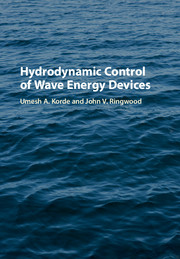Book contents
- Frontmatter
- Contents
- Preface
- Acknowledgments
- Part I Introduction
- Part II The Basics
- Part III The Hydrodynamics
- Part IV Velocity Control Using a Hydrodynamic Model
- Part V Control by Optimizing a Performance Index
- Part VI Toward Overall WEC System Hydrodynamic Optimization
- 13 Position and Force Constraint Analysis and Optimization
- 14 Interaction between Control and Optimum System Design
- Part VII In Closing
- References
- Index
13 - Position and Force Constraint Analysis and Optimization
from Part VI - Toward Overall WEC System Hydrodynamic Optimization
Published online by Cambridge University Press: 05 September 2016
- Frontmatter
- Contents
- Preface
- Acknowledgments
- Part I Introduction
- Part II The Basics
- Part III The Hydrodynamics
- Part IV Velocity Control Using a Hydrodynamic Model
- Part V Control by Optimizing a Performance Index
- Part VI Toward Overall WEC System Hydrodynamic Optimization
- 13 Position and Force Constraint Analysis and Optimization
- 14 Interaction between Control and Optimum System Design
- Part VII In Closing
- References
- Index
Summary
Introduction
Even at this early stage of wave energy development, it is largely accepted that most devices will have two modes of operation: the “normal” mode of operation, where power is converted from the waves into a usable form (water pressure, electricity, etc.), and a further “survivability” mode, which the device will need to enter when the wave excitation forces become too great for the motion and force constraints to be simultaneously satisfied. However, the development of supervisory control to configure a device into survival mode is not the focus here; though, indeed, there have been a number of methods proposed, many of which are particular to specific device types. Rather, the focus here is on the interplay between the wave excitation force and the physical constraints of the wave energy device, namely, the force and displacement constraints, and it will be assumed that, where system constraints cannot be satisfied, the wave energy device must enter survival mode. We note that there may also be velocity constraints related to limitations of rate of movement of various system components. While velocity constraints can also be included in the formulation framework, we focus on the main constraints of force and position, for brevity.
The suggested interplay between the force and displacement (amplitude) constraints and the wave excitation force is illustrated conceptually by Fig. 13.1. A situation that satisfies the constraints for a given wave excitation force, Fe, is indicated by an intersection of the force and position sets, and this is the region within which the optimal constrained control problem can be solved. In general, larger position and force constraints are indicated by circles of greater radii, while larger excitation forces are represented by a greater distance between circle centers, indicating the increasing difficulty of simultaneously satisfying displacement and force constraints. Ideally, we would like to identify the functions f1( ), f2( ), and f3( ) so that the construct in Fig. 13.1 can be generated for a specific wave energy device. In addition, it would be beneficial if some indication of the energy landscape could be provided so that, where constraints are not immediately satisfied, some guidance is available to allow captured energy to be maximized by virtue of a constraint relaxation.
Information
- Type
- Chapter
- Information
- Hydrodynamic Control of Wave Energy Devices , pp. 297 - 315Publisher: Cambridge University PressPrint publication year: 2016
